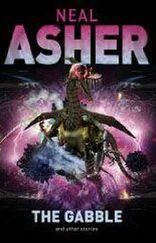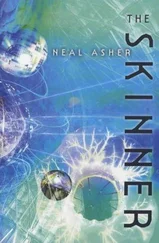He turned and left the bridge to go and join his comrades Arach and Smith. With them he hoped to find a distraction from the void currently extending beyond this ship, a void somehow horribly attractive to him and seemingly intent on drawing him in.
* * * *
This G-type star had been of no more than scientific interest to the Polity, or anyone else, after the arrival of the first probe here nearly a century before, since, even though it lay within Polity space, it was remote from all civilized worlds. This was why the haiman Orlandine had chosen it. She arrived some distance out and immediately activated her ship’s chameleonware to conceal it, before scanning for the kind of automated watch stations Polity AIs tended to scatter about in places like this simply to collect scientific data… and to watch. There were two of them, she discovered, in orbit of the sun’s single gas-giant planet.
Using her ship’s chameleonware, she spent some weeks invisibly approaching the said stations, furtively docking, and in each sowed a Jain mycelium she had prepared. These mycelia absorbed surrounding material and spread out like hair-thin vines, attaching to each station’s power supply and bonding in parallel to instrumentation. Within a few hours she took control and was able to edit the data the sensors were collecting for the stations’ monthly U-space broadcasts to the runcible AI on the nearest civilized world. Next, and most importantly, she took control of the software that activated upon detecting any unusual activity in this planetary system, and instructed it to send that data direct to her. Once this was done she turned off Heliotrope’s chameleonware — a technology she did not like to run for too long since it was so greedy for energy. Now the stations were blind to her presence, and to anything she did here.
Next she landed Heliotrope on the smallest of the eight moons orbiting this sun’s single planet — the gas giant. This moonlet was geologically active, though what erupted in plumes up to five miles high from its icy volcanoes was not magma but liquid nitrogen, dust and methane compounds. The temperature here rose only forty degrees above absolute zero. There were lakes on the moonlet’s surface and sometimes it rained, but water was as solid as iron and instead the stuff that fell from the blue and green clouds to gather on the surface was liquid methane and ethane.
Because of these low temperatures, what with the sun being a glowing orb only slightly larger than the other stars, there was a lack of energy for Orlandine to utilize. A particular one of the higher-energy worlds closer to the giant — a moon sufficiently heated by geological activity for it to geyser boiling sulphur and for liquid water to sometimes flow on its surface — might have been a more suitable choice. However, that same geological activity made it a dangerous place, and she had decided to conduct a lengthy study of it before relocating there. She confidently chose this world first because already she had experience of using her Jain technology in a low-temperature environment, on the occasion of blowing up a similar moonlet.
Before attempting anything else, Orlandine used the ship’s drill to grind down a few feet into the surface and plant a seed which, powered by Heliotrope’s fusion reactor, germinated and began to sprout Jain tendrils. These began boring through the surrounding rock and ice, using microscopic drills, and to in turn sprout nanotubes which periodically grew quantum processors the size of salt grains along their route. In time this structure would begin to find power sources like radioactives, areas of geothermal activity and reactive chemicals. Once she was sure it was busily working as required, Orlandine decided to go outside.
Orlandine’s carapace — a ribbed metal shell attached to her back from the nape of her neck to the base of her spine, loaded with the advanced technology that made her haiman — was now permanently bonded to her body by the mycelium she had used to increase her capabilities close to those of a major AI, but she hardly noticed it now. The spacesuit she wore — and had only removed once to tend to a wound she had received while preparing that previous icy moonlet for destruction — was specially made for haimans and incorporated the carapace. Similarly it incorporated the cut-down assister frame she also wore: a device that plugged into the carapace and presented two metal arms at just above waist level, and of which she possessed greater and more accurate control than over her own arms of flesh, bone and blood.
She began disengaging herself from Heliotrope’s interface sphere. This took a little while because she needed to physically disconnect from the Jain-tech aboard, and it tended to not want to let go of her — or, rather, there was some part of her that did not want to let it go. Once the numerous hair-thin tendrils linking her to the main mycelium in the ship were all severed, all that remained was her disconnection from the simpler Polity technology. Upon the disengage instruction, a power supply plug retracted from the spinal socket in her carapace and withdrew into the chair behind her, then lines of optic plugs on the ends of curved arms retracted from the sides of her carapace and hinged back out of sight on either side of her chair. The sensation of physical disconnection, though she did remain connected by electromagnetic means, was almost like being muffled from the rest of the world by a thick blanket, so, to compensate, Orlandine opened up the sensory cowl positioned behind her head as she pushed herself upright using the two limbs of her assister frame.
The door into the interface sphere whoomphed up from its seals and slid aside, and she pulled herself up and out into the corridor beyond. At the end of the corridor she entered her living area, then headed towards the airlock. A series of brief mental instructions started the airlock ahead of her cycling open and simultaneously closed up her spacesuit. The segmented back of her spacesuit helmet rose up between her head and the petals of her sensory cowl, while the ribbed chainglass visor rose up from the front of her suit collar to engage with the helmet at the apex, its segments locking together to give an optically perfect finish. She now considered the possibility of installing a shimmer-shield as a suit visor, since it would be more convenient, and as she entered the airlock, then finally stepped outside, a thought set automated machines within the ship to work on this possibility.
Shutting off all but her human sight, Orlandine saw only shadows. However, light amplification revealed thick ice underfoot, eaten away in places to show numerous laminations glittering in rainbow colours. Scanning deep into the ice with her sensory cowl, Orlandine picked out numerous boulders, the branching of underground streams of ethane and, of course, the rapidly expanding capillary-like structures of her recently planted mycelium. In the distance jagged peaks rose like gnarled canines in a deformed jaw, and beyond them the stars shimmered behind wisps of violet cloud. To her right the tight curve of the horizon was more easily visible, soot-black against a pink dome that was the edge of the gas giant, its magnetic fields creating twisted aurorae outside the normal human visible spectrum. Orlandine was enchanted, fascinated, and the species of joy she felt was almost a pain in her chest. Even through only slightly augmented human senses, this view would have been beautiful; seeing it across a wide band of the electromagnetic spectrum made it glorious. And, standing there knowing her capabilities and reviewing her plans, Orlandine felt herself to be the lord of all she surveyed. This feeling lasted only until the signal arrived.
Читать дальше












